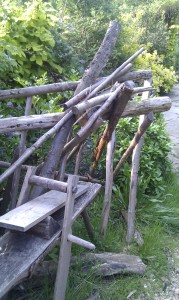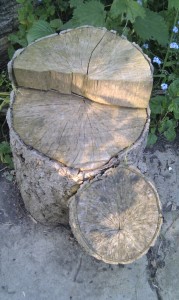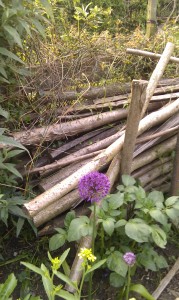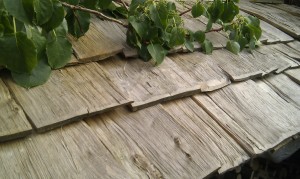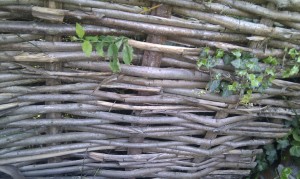Archive for the ‘craft’ Category
an industry of hornbeam
I’m walking through our garden. There’s normal garden stuff: trees, shrubs, patio, table and chairs, a washing line. Not much lawn but that’s down to the chickens.
But all about there are also the signs that an (untidy?) craftsman works here.
A cleaving brake in the veg bed, a pole lathe that is fighting a losing battle with Boston Ivy, a shave horse sheltering under the jasmine, a persuader that has rolled under the rhubarb, chopping blocks next to the path, a saw horse that has perhaps seen better days.
All around there are remnants, waste, bits in need of a purpose: saw dust, wood shavings, cleaved sticks, trimmed ends, rejected twigs.
There are finished products too. Gate hurdles to protect the crops from pecking chickens and stampeding puppies. Woven hurdles screening compost and covering gaps in the fence. Beanpoles and pea sticks in the vegetable beds. Oak shingles on the wood shed and some spares in it. Firewood and kindling. Charcoal in bags in the shed.
It’s a strange sight in this urban garden although the neighbours are equally baffled by the chickens and even the normal horticultural stuff.
It stops people in their tracks when they stumble across Iain at work in the woods. We don’t think of woodlands as places of work, except maybe in the sense of industrial scale forestry in Canadian pine forests. Finding a lone guy with a pile of sticks and a billhook is a curiousity.
Our wood has ponds the agent claimed are ancient earthworks. Whatever the truth of that, it is unmistakable from the shape of the trees that sometime last century someone else worked these woods.
Woods were places of work and tools just as farms and cities are.
inheritance
None of my grandparents are still alive. Helen died when my mum was little,  Walter when I was just out of university and May & Tom shortly after I got married. I have some things that might traditionally be considered my inheritance from them, although some of the things might seem a little odd.
From Walter I have cigar boxes, tins, wooden boxes, a stack of leather skins and offcuts, old curtains, and photos. From May & Tom I have a meat slicer, pie tins, knifes, a Mrs Beeton, a stone rabbit, a red honeysuckle plant, jewellery, and photos.
Walter was stubborn and eccentric. Â A big food lover. So much of a storyteller that we don’t know how much of the family history is true. He was a cobbler, creative, a good craftsman but not such a good businessman.
Helen I never knew. She was a matron. Mum’s memories make her sound gentle and caring. She was able to live with Walter so must have had super-human tolerance and patience. And thrift.
May was an organiser. She had a document tabulating all the holidays they had even taken, with destinations, dates and travelling companions. Food cupboards had lists of their contents pinned to the back of the doors. Food prices at different stores were noted in a book kept by her armchair. Household accounts were monitored with double entry book-keeping. She’d been a civil servant before getting married. They let her stay on so long as she kept using her maiden name but her working life came to end once my dad was born. A whole lot of pent-up organisational ability got directed towards running the home like a miniature government department. I recognised a lot in Hallie’s My Grandmother the IA presentation.
Tom was very different to May. He needed a few cigarettes a day, friendly chats and no office politics at work. That was about it for his demands from life.
So other things I may have inherited are pleasure in a simple life, in organising things and in crafting things. And probably a bit more from Walter than I prefer to notice.
book: Shop Class as Soulcraft by Matthew B. Crawford
I’ve been reading extracts of Shop Class as Soulcraft: An Inquiry Into the Value of Work by Matthew B. Crawford. Crawford has a PhD in Political Philosophy, once worked writing abstracts for an academic journal service and now runs a motorcycle repair shop. His book, which began as an article in the New Atlantis, champions the virtues of using your hands to make and repair things.
He tells some fairly depressing tales of cubicle life:
“The quota demanded, then, not just dumbing down but also a bit of moral re-education, the opposite of the kind that occurs in the heedful absorption of mechanical work. I had to suppress my sense of responsibility to the article itself, and to others — to the author, to begin with, as well as to the hapless users of the database, who might naïvely suppose that my abstract reflected the author’s work. Such detachment was made easy by the fact there was no immediate consequence for me; I could write any nonsense whatever….
A good job requires a field of action where you can put your best capacities to work and see an effect in the world. Academic credentials do not guarantee this…
The good life comes in a variety of forms.”
four tools for managing thoughts
A consultant I’m working with is loving Compendium. Weird to see something I’m used to in the Open University universe in such a commerical setting. Surely they ought to be forking out for some expensive sparkly software?
Anyway, that started me thinking about tools for organising your thoughts and the stuff I normally use:
- A3 paper -Â I swear I think differently off-line. Good pen, nice paper and lots of space. I don’t keep the paper though. It either goes in the compost (and eventually becomes tomatoes) when the thinking is done, or gets converted to electronic form for keeping. Short term management only.
- Google Notebook – every unstructured thought gets dumped in Notebook, usually via the Firefox plug-in. When I’m online they go straight in but if I’ve been musing on paper in meetings then I upload later. Eventually they evolve into a loosely structured set of notebooks and sections. I tidy up a bit but my notebook has a shockingly mixed bag of categories and still has “my first notebook” aka the miscellaneous one. Which is an IA sin.
- Delicious. ‘Only’ a bookmarking tool but actually a repository of half-formed thoughts and some more concrete ideas. I make notes against some of the bookmarks but everything gets tagged. Unformed ideas get big general tags but as ideas get beaten into submission the tagging gets more focused. Again used mostly via Firefox plug-in.
- FreeMind. For mindmapping software I’ve used Mindmapper and Inspiration in the past and I’d looked into Compendium. Visio will do at a pinch. But FreeMind came ready installed on my EEE so I’ve been using that lots recently. And quite happily so. Some of the more useful A3 scribbles have ended up in Freemind.
Google Notebook in particular has helped me get to Desk Zero (well, almost). The scarily clear desk does help me stay organised and is also a bit of internal marketing. Everyone seems gob-smacked that I keep it clear and this seems to establish my credentials for sorting out our digital mess. And makes my colleagues think I’m a bit of a weirdo.
David Gauntlett’s inaugural lecture
I’m hugely looking forward to David Gauntlett’s inaugural lecture on 12th November.
“The particular significance of Tim Berners-Lee’s original vision is that it involved people making and sharing things – all users as contributors, not just readers. Thus began the shift from the ‘mass audience’ towards creative individuals and communities. David Gauntlett has had a long engagement with the Web, having produced the award-winning website Theory.org.uk for over a decade. Several years before the rise of ‘Web 2.0’, he was writing about the Web as a creative and collaborative playground of everyday culture, politics, and self-expression. He has continued to embed an interest in the Web with broader research about creativity and ways to engage people in social research and social issues.
Gauntlett considers these themes in the context of a broader growth in home-made culture, craft, recycling and remaking, which connects with environmental issues, transition towns and cities, and therefore – in one grand bound – the future of the planet. He will argue that this making-and-sharing culture may foster the ‘tools for thinking’ which will be required to solve social and environmental problems.”
The wine reception is all ‘sold out’ but that’s not the best bit, is it? Register for the free lecture here http://www.12november.org.uk/.
visual research methods
I had the opportunity last week to attend a brilliant course called An Introduction to Visual Methods.
“The aim of this workshop is to provide participants with a step-change career enhancing skills in visual methods; and to provide an ongoing and integrated visual methods resource for researchers with experience in visual methods at intermediate level that is stimulating, challenging and grounded in ‘best practice’.”
Dr Jon Prosser and friends are running an ESRC funded initiative to “build visual method capacity across the social sciences. Part of the initiative was these dirt cheap training courses, aimed at academic and non-academic researchers alike.
The two days involved three hands-on activities and a number of presentations covering:
- Katherine Davies : photo elicitation and family tree drawing to explore family resemblances and sibling relationships
- Stuart Muir: video diaries to explore contemporary rituals
- Rob Walker on children’s photo diaries
- Andrew Clark on map making and walkabouts to understand urban social geography
- Tessa Muncey on auto-ethnography through writing and photos
- David Gauntlett: making documentaries with kids, drawings of celebrities, identity models made of Lego
- Steve Higgins: using cartoon templates to find out childrens views
- Ruth Holliday: using video diaries to explore gender identity
- Jon Prosser on the ethics of visual methods.
There’s a Visual Methods Symposium in July that will explore some of these themes in more depth.
Library of Congress webcasts
The Library of Congress webcast archive is another great repository of thought provoking video on all sorts of topics from Extraordinary Rendition to First Words in Print to Avoiding the Fate of the Mayans.
remembering making stuff
Reading the Science of Lego Serious Play brought back many memories of school.
“constructivist learning happens especially well when people are engaged in constructing a product, something external to themselves”
I remember lots of making stuff: making clay birds & fruit pictures in art lessons; designing stamps and fruit boxes in product design; a bag in home economics; and a mirror, a chess box and a candlestick in CDT.
But it wasn’t just in the obvious classes. I also remember making a seed packet for rice in geography, making paper chains in an economics class, making models of roman bath houses in history. I’ve still got all that stuff – except the paper chains.
The odd thing is I was a science and maths geek. I don’t really remember those classes. I haven’t kept any things from them.
Media and Everyday Life – David Gauntlett
DG’s video of Media & Everyday Life represents big media with pictures of the ecclesiastical Broadcasting House. Not sure what David would think of our BBC building, the Broadcast Centre. It looks more like a warehouse than a church. And White City building looks a bit like it should be in Gotham City.
Lego features, of course, in the form of Lego gardens (combining two of my favourite things!) to show the difference between Web 1.0 and Web 2.0.
And towards the end David talks about Richard Sennett’s The Craftsman and his theory that craftsmanship gives a sense of well-being. The Craftsman has been on my wishlist for a while and I’m having to fight the urge to go on a book buying splurge.
BBC Innovation Labs
The BBC’s Innovation Labs are back on. This year’s Labs are aimed at “independent new media & vision companies in … Scotland, North East England, North West England and Wales & West Midlands”.
The labs provide
• Participation in an intensive creative workshop with peers and expert mentors
• An opportunity to pitch a project to BBC New Media commissioners
• Access to business advice, mentoring and development finance from other sources
• Retention of any IP that they develop
• A £5,000 fee for each of the selected teams
